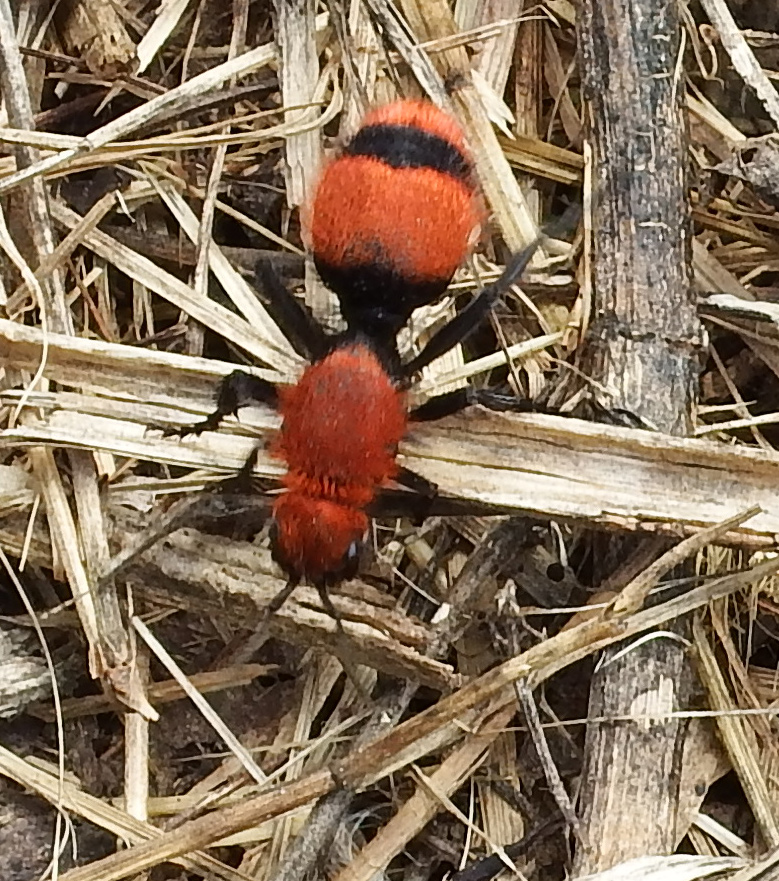What’s red and fuzzy and crawls on the ground?

Usually, things are red for a reason. It’s a color that really shows up. If you want to stand out, wear red. Of course, if you are small and surrounded by larger, hungry things, red might not be your color.
So, what should we make of this friend that I ran into off the trail near the Jackson Hill pedstrian bridge? She isn’t large, she isn’t particularly fast, and she sure is red.
If your guess was, “she looks kind of dangerous,” you are a winner!
Red is also the color chosen by really deadly things that don’t care if you can see them, because they have the power to knock you out. In fact, the color becomes an advertisement for just how dangerous they are.
My friend is a wasp known as a Red Velvet Ant. She’s called an ant because she doesn’t have any wings and so, crawls around like an ant. But don’t mistake her for something so innocent. Velvet ants are considered to have the fourth most painful sting of any insect in the world. Our friend’s nickname is Cow Killer Ant because her sting is that painful. To my knowledge, no cows have ever died from a velvet ant sting. In fact, the sting isn’t particularly dangerous, it just causes a huge amount of pain.
And don’t think stomping on her is a good idea, either. Velvet ant exoskeletons are so tough that entomologists find they can’t stick a pin through them. If you run into a Velvet Ant, just admire her and move on.
Velvet ants are so well defended that biologists have been puzzled as to why. In addition to being bright red, having a powerfully painful sting, and being almost impossible to crush, she can excrete a chemical that exactly mimics the alarm pheromone of ants. You would think something this bristling with armaments would have some fairly dangerous enemies, but velvet ants lead solitary lives and nothing much seems to prey on them. There is a thought that there was once a predator who is long extinct, yet the velvet ant persists, well defended against nothing in particular.
She spends all her time crawling on the ground, looking for nests of ground-nesting bees. Many of our native bees nest in the ground. In fact some of those leaf-cutter bees I found last week could be potential hosts for our velvet ant’s young.
When she finds the nest of a bee, she will crawl inside, chew through the bee cocoon and lay an egg on the pupa within. Her larva lives by consuming the bee larva on whom he was born.
When the velvet ant larva finally emerge in their adult state, they mate almost immediately. I am going to assume that the burden of finding said mate falls to the males, because they have wings. The females lack them throughout their lives. Since crawling slowly along the ground hoping to bump into another of your species seems like a lame survival strategy for such an obvious survivor, we will assume the winged males do the finding. After they mate, the boys die and the wingless females begin their long quest to find a host for her young.
On a tour once, someone asked me what the purpose of wasps were. Living things don’t have purposes, they are their own purpose, but they do usually fit together with other things and can be generally incorporated into the universal life process. Bees pollinate flowers. Buffalo keep prairies in good health by eating grasses. Birds eat seeds and poop them out, dispersing them far and wide. But wasps are just plain scary. They do visit flowers for nectar, but they have none of the specialized pollen carrying organs that bees have, so they generally don’t contribute to plant pollination except in certain specialized cases.
What wasps do really well, however, is to keep the rest of the world from being hip deep in caterpillars and other insects. Wasps are what they look like. Assassins.

